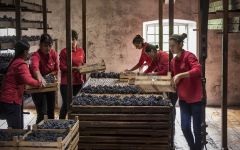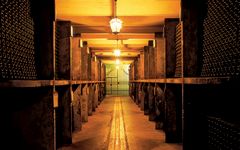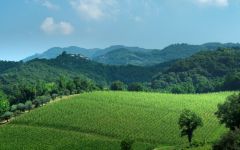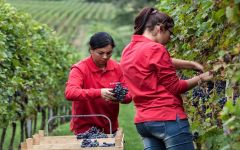Bertani Amarone Classico 2009
-
James
Suckling - Decanter
-
Wine
Enthusiast -
Wine
Spectator



Product Details
Your Rating
Somm Note
Winemaker Notes
It can be drunk with red meat, game, mature cheeses, but it is also perfect as a meditation wine at the end of a meal.
Professional Ratings
-
James Suckling
A really beautiful Amarone that shows fresh, glazed cherries, red licorice, dried nutmeg, caramelized orange peel, dried rose petals, hot stones and red-plum essence. Medium to full body, really tight and compact tannins, pinpoint acidity and a long, spicy finish. So dry, linear and well defined. Drink now or hold.
-
Decanter
Bottled in January 2017 and released to the market during the upcoming April edition of Vinitaly, 2009 was a warm, dry vintage just as in Bordeaux, yet favored here by a drastic range of diurnal and nocturnal temperatures. The wine is full of youth apparent by the color and almost estery on the nose, with a bright cherry aroma accentuated by notes of bay leaf and a peppery finish. The acidity is still quite racy undermining firm, ripe tannins while balancing high alcohol (15,5%). Bottle ageing will help to give way to the beloved, restrained Bertani style. Drinking Window 2020 - 2040
-
Wine Enthusiast
This opens with quintessential Amarone aromas of baked plum, dark spice, underbrush, leather and pipe tobacco. The full-bodied palate offers dried cherry, prune, toasted hazelnut, star anise and clove set against fine-grained tannins. Drink through 2024.
-
Wine Spectator
A subtle red, with a hint of smoky mineral underscoring the dried cherry, cocoa powder and dried thyme notes. Fresh and elegant, framed by fine tannins and offering a lingering, silky finish. Drink now through 2025.
Other Vintages
2012-
James
Suckling
-
James
Suckling
-
James
Suckling
-
Wine
Spectator -
Wine
Enthusiast
-
Robert
Parker -
Wine
Enthusiast -
Wine
Spectator
-
Wine
Enthusiast -
Wine
Spectator
-
Robert
Parker -
Wine
Enthusiast -
Wine &
Spirits
-
Robert
Parker
-
Wine
Enthusiast -
Robert
Parker

With hundreds of red grape varieties to choose from, winemakers have the freedom to create a virtually endless assortment of blended red wines. In many European regions, strict laws are in place determining the set of varieties that may be used, but in the New World, experimentation is permitted and encouraged resulting in a wide variety of red wine styles. Blending can be utilized to enhance balance or create complexity, lending different layers of flavors and aromas. For example, a red wine blend variety that creates a fruity and full-bodied wine would do well combined with one that is naturally high in acidity and tannins. Sometimes small amounts of a particular variety are added to boost color or aromatics. Blending can take place before or after fermentation, with the latter, more popular option giving more control to the winemaker over the final qualities of the wine.
How to Serve Red Wine
A common piece of advice is to serve red wine at “room temperature,” but this suggestion is imprecise. After all, room temperature in January is likely to be quite different than in August, even considering the possible effect of central heating and air conditioning systems. The proper temperature to aim for is 55° F to 60° F for lighter-bodied reds and 60° F to 65° F for fuller-bodied wines.
How Long Does Red Wine Last?
Once opened and re-corked, a bottle stored in a cool, dark environment (like your fridge) will stay fresh and nicely drinkable for a day or two. There are products available that can extend that period by a couple of days. As for unopened bottles, optimal storage means keeping them on their sides in a moderately humid environment at about 57° F. Red wines stored in this manner will stay good – and possibly improve – for anywhere from one year to multiple decades. Assessing how long to hold on to a bottle is a complicated science. If you are planning long-term storage of your reds, seek the advice of a wine professional.

Producing every style of wine and with great success, the Veneto is one of the most multi-faceted wine regions of Italy.
Veneto's appellation called Valpolicella (meaning “valley of cellars” in Italian) is a series of north to south valleys and is the source of the region’s best red wine with the same name. Valpolicella—the wine—is juicy, spicy, tart and packed full of red cherry flavors. Corvina makes up the backbone of the blend with Rondinella, Molinara, Croatina and others playing supporting roles. Amarone, a dry red, and Recioto, a sweet wine, follow the same blending patterns but are made from grapes left to dry for a few months before pressing. The drying process results in intense, full-bodied, heady and often, quite cerebral wines.
Soave, based on the indigenous Garganega grape, is the famous white here—made ultra popular in the 1970s at a time when quantity was more important than quality. Today one can find great values on whites from Soave, making it a perfect choice as an everyday sipper! But the more recent local, increased focus on low yields and high quality winemaking in the original Soave zone, now called Soave Classico, gives the real gems of the area. A fine Soave Classico will exhibit a round palate full of flavors such as ripe pear, yellow peach, melon or orange zest and have smoky and floral aromas and a sapid, fresh, mineral-driven finish.
Much of Italy’s Pinot grigio hails from the Veneto, where the crisp and refreshing style is easy to maintain; the ultra-popular sparkling wine, Prosecco, comes from here as well.







